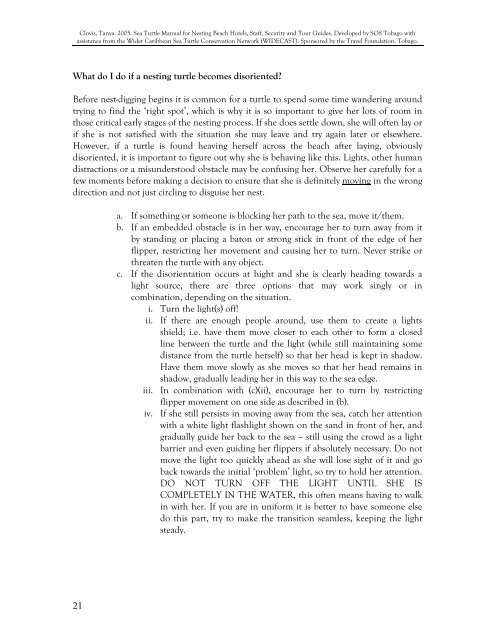Clovis, Tanya. - WIDECAST
Clovis, Tanya. - WIDECAST
Clovis, Tanya. - WIDECAST
You also want an ePaper? Increase the reach of your titles
YUMPU automatically turns print PDFs into web optimized ePapers that Google loves.
<strong>Clovis</strong>, <strong>Tanya</strong>. 2005. Sea Turtle Manual for Nesting Beach Hotels, Staff, Security and Tour Guides. Developed by SOS Tobago with<br />
assistance from the Wider Caribbean Sea Turtle Conservation Network (<strong>WIDECAST</strong>). Sponsored by the Travel Foundation. Tobago.<br />
What do I do if a nesting turtle becomes disoriented<br />
Before nest-digging begins it is common for a turtle to spend some time wandering around<br />
trying to find the ‘right spot’, which is why it is so important to give her lots of room in<br />
those critical early stages of the nesting process. If she does settle down, she will often lay or<br />
if she is not satisfied with the situation she may leave and try again later or elsewhere.<br />
However, if a turtle is found heaving herself across the beach after laying, obviously<br />
disoriented, it is important to figure out why she is behaving like this. Lights, other human<br />
distractions or a misunderstood obstacle may be confusing her. Observe her carefully for a<br />
few moments before making a decision to ensure that she is definitely moving in the wrong<br />
direction and not just circling to disguise her nest.<br />
a. If something or someone is blocking her path to the sea, move it/them.<br />
b. If an embedded obstacle is in her way, encourage her to turn away from it<br />
by standing or placing a baton or strong stick in front of the edge of her<br />
flipper, restricting her movement and causing her to turn. Never strike or<br />
threaten the turtle with any object.<br />
c. If the disorientation occurs at hight and she is clearly heading towards a<br />
light source, there are three options that may work singly or in<br />
combination, depending on the situation.<br />
i. Turn the light(s) off!<br />
ii. If there are enough people around, use them to create a lights<br />
shield; i.e. have them move closer to each other to form a closed<br />
line between the turtle and the light (while still maintaining some<br />
distance from the turtle herself) so that her head is kept in shadow.<br />
Have them move slowly as she moves so that her head remains in<br />
shadow, gradually leading her in this way to the sea edge.<br />
iii. In combination with (c)(ii), encourage her to turn by restricting<br />
flipper movement on one side as described in (b).<br />
iv. If she still persists in moving away from the sea, catch her attention<br />
with a white light flashlight shown on the sand in front of her, and<br />
gradually guide her back to the sea – still using the crowd as a light<br />
barrier and even guiding her flippers if absolutely necessary. Do not<br />
move the light too quickly ahead as she will lose sight of it and go<br />
back towards the initial ‘problem’ light, so try to hold her attention.<br />
DO NOT TURN OFF THE LIGHT UNTIL SHE IS<br />
COMPLETELY IN THE WATER, this often means having to walk<br />
in with her. If you are in uniform it is better to have someone else<br />
do this part, try to make the transition seamless, keeping the light<br />
steady.<br />
21
















